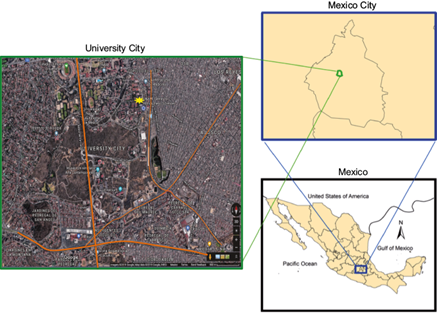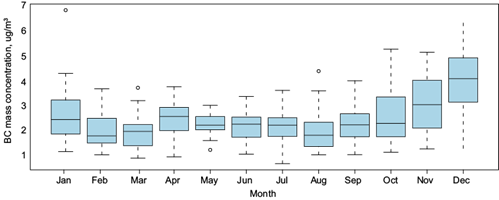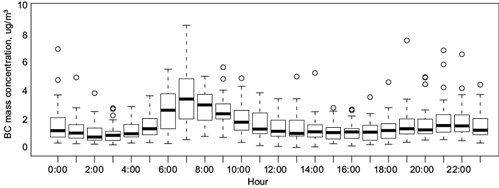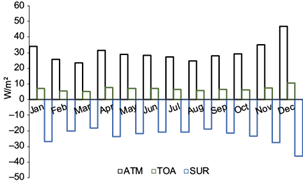1. Introduction
The Valley of Mexico Metropolitan Zone (VMMZ) is an urban, semi-urban and rural conglomerate spanning three federative entities with a total of 60 municipalities and 16 mayoralties, with an area of 7954 km2 and a population in 2010 of 20 116 842 million inhabitants (Sedesol, 2012). Mexico City, the core of the VMMZ, is the capital of the country. In 2015 it had a population of 8 918 653 inhabitants (INEGI, 2016) and an additional floating population of five million (Ahued, 2012). Aerosols and criteria pollutants are emitted every day in vast quantities, often exceeding air quality standards (Velasco and Retama, 2017).
The effect of aerosols on climate is normally quantified in terms of aerosol radiative forcing (Chung, 2012). Radiative forcing is defined as ‘the change in net (down minus up) irradiance (solar plus longwave; in W m-2) at the tropopause after allowing for stratospheric temperatures to readjust to radiative equilibrium, but with surface and tropospheric temperatures and state held fixed at the unperturbed values” (Ramaswamy et al., 2001). Direct radiative forcing is an unbalance in atmospheric radiation budget caused by absorption and scattering of sunlight. A positive radiative forcing causes a heating of the atmosphere, a negative radiative forcing, a cooling of the atmosphere.
Black carbon (BC) is a particulate, liquid and gaseous aerosol conglomerate produced from the incomplete combustion of fossil fuels, wood and other biomasses (UNEP-WMO, 2011; US-EPA, 2012). In addition to greenhouse gases, whose increase in the atmosphere produces a rise in global temperature, BC warms the atmosphere through both direct and indirect effects due to its strong interaction with radiation, absorbing not only radiation reflected by the surface of the Earth (as greenhouse gases do) but also direct solar radiation. Thus, it absorbs a million times more energy per mass unit than CO2 (UNEP/WMO, 2011). It also exerts indirect radiative forcing through impacts on cloud dynamics and ice albedo (e.g., Flanner et al., 2007; Shi-Chang, 2016), and it affects health (Janssen et al., 2012; Briggs and Long, 2016; Lin et al., 2016; Jeong et al., 2017; Luben et al., 2017), landscape (Raunemaa, 1994; Novakov and Rosen, 2013), and, in general, air quality (Bice et al., 2009; Fawole et al., 2016). Black carbon radiation absorption produces atmospheric heating and reduced sunlight reaching the surface and reflecting to the atmosphere (Bond et al., 2013).
Black carbon characterization is difficult as it undergoes aging and short half-life processes (Bond et al., 2013). In addition, black carbon radiative forcing depends on its environment (Nair et al., 2014); therefore, determining the radiative forcing of black carbon implies a high uncertainty, and its estimate over time has been integrated from +0.10 W m-2 in the Second Assessment Report of the IPCC to +0.40 (+0.05 to +0.80) W m-2 in the Fifth Assessment Report (Myhre et al., 2013).
According to several emission inventories (Bond et al., 2004; Ito and Penner, 2005; Lamarque et al., 2010; Wang et al., 2014; Wang, 2015), the majority of the global BC emissions comes from Asia, Africa, and Latin America; however, the contribution from developed countries remains considerable. For instance, the USA contributes with 8% to the global emissions (US-EPA, 2012).
Mexico´s Intended Nationally Determined Contribution (INDC) pledged a reduction of black carbon emissions of up to 51% by 2030 with respect to those in 2000, based on an average estimate of the global warming potential of this pollutant. In order to know the exact contribution of BC to Mexico’s emission inventory, it is necessary to estimate several BC properties, such as its radiative forcing and its effects on the radiative heating of the atmosphere, among others. In this work, a technique based on the use of available remote-sensing and ground-based data along with the OPAC and SBDART algorithms were applied to estimate some black carbon optical properties and radiative forcing in the south of Mexico City during 2015.
2. Methodology
2.1 Site location
Data from the National Black Carbon Monitoring Network was obtained for the year 2015. This network was recently created as a collaborative effort between the National Autonomous University of Mexico (UNAM) and the National Institute of Ecology and Climate Change (INECC) (Ortinez, 2016). It currently consists of five monitoring stations throughout the country. The University City (CU) station, located on the roof of the Center for Atmospheric Sciences at the National Autonomous University of Mexico in the south of Mexico City, has one of the most reliable and complete databases. The CU station is inside the main UNAM campus, limited by two major freeways, the Periférico, a freeway that surrounds the city with four lanes each direction; and Insurgentes avenue, which runs across the city from north to south, starting in the Pachuca highway and ending in the Cuernavaca (one of the most visited weekend destinations) highway. Cargo vehicles enter (leave) Mexico City from (to) the south of the country through this highway, and the Metrobús, a diesel-driven confined passenger bus, circulates through Insurgentes avenue. In the neighborhood of the CU station, land use is medium and high income urban and services within a rocky natural protected area (Fig. 1).

Fig. 1 University City (CU) black carbon and air quality-monitoring station, located on the roof of the Center for Atmospheric Sciences building, inside the University campus (denoted by a yellow star). The main roads of the area are depicted in orange: Insurgentes avenue, crossing the city from north to south; Periférico freeway, which surrounds the city in a circle; and IMAN and Dalias avenues (in lighter orange lines).
2.2 Data arrangement
Black carbon data from the recently created National Black Carbon Network (Peralta, 2017) were used. The CU monitoring station is the only site, from the five monitoring sites along the country, with a complete and reliable database for a whole year, 2015. Black carbon values were arranged in a monthly classification. The instruments used for black carbon monitoring were an aethalometer (Magee Scientif AE33) with eight wavelength span (from 430 to 960 nm; http://www.mageesci.com/) and a photoacustic extinctiometer (PAX at 870 nm; http://www.dropletmeasurement.com/) with a ± 0.2 μg/m3 resolution and 1 s response time averaged over 1 min. Data used in this work were obtained with PAX equipment.
2.3 Calculations with OPAC
Available AERONET (Holben et al., 2001; Dubovik et al., 2002) data at level 1.5 were used to calculate the Ångström exponent at two wavelength intervals, 340-500 (α340-500) and 500-850 nm (α500-840) as the slope of the wavelength vs. the aerosol optical depth (AOD) log plot. The selected height profile was used according to the recommendations of Hess et al. (1998). The percentage of relative humidity was selected as the closest to the recorded mean value.
Data was computed with the Optical Properties of Aerosols and Clouds (OPAC) model (Hess et al., 1998) using the urban option. Main components of this model are soot, water-soluble compounds, insoluble compounds, and sulfates. After an iterative process, concentrations were fitted for all components except soot, until the spectral optical depths and the Ångström exponents were consistent with the observations.
2.4 Calculations with SBDART
The Santa Barbara DISORT Atmospheric Radiative Transfer (SBDART) model (Ricchiazzi et al., 1998) was used to estimate radiative fluxes in the atmosphere. With the new spectral optical depths, a new Ångström exponent was defined. The tropical profile was also selected, modifying the predetermined values of columnar ozone to those published by Goering et al. (2005). Surface albedo from ORNL-DAAC (2008) was used. The calculations for each month and season included the following parameters: atmosphere with composite aerosols (with soot), atmosphere without aerosols, and atmosphere with composite aerosols (without soot).
Radiative fluxes obtained from SBDART were used to estimate radiative forcing included top-down (TOPDN), top-up (TOPUP), top-direct (TOPDIR), bottom-down (BOTDN), bottom-up (BOTUP), and bottom-direct (BOTDIR). To calculate the top of the atmosphere (TOA) forcing, we used the following equation:
Eq. (2) was used to obtain the surface forcing:
The values of NET flux were calculated with Eq. (3):
Atmospheric radiative forcing was obtained by subtracting surface forcing from TOA forcing:
And black carbon radiative forcing was calculated as follows:
3. Results
Some meteorological parameters recorded at CU station are shown in figure 2. The average annual temperature is around 15 ºC. Its location close to the mountains dampens the wind free circulation, which registers an average of 2 m s-1, with a diurnal direction from the north and from the mountain to the south at night; such a wind pattern causes the south of Mexico City to be the receptor of emissions from the north of the city, where many industrial facilities and cargo and passenger transportation activities are located. Relative humidity is around 50% during dry months and 70% in the rainy season.
Black carbon monthly average mass concentration values are depicted in figure 3. The average concentration of black carbon is higher in November and December than in other months. According to Retama et al. (2015), seasons in Mexico City can be described as cool-dry (November-March), rainy (June-October) and warm-dry (April-May). Following these denominations, highest black carbon concentrations correspond to the cool-dry season. This seasonal pattern is common in urban locations, being its cause a lower height of the planetary boundary layer (Gupta et al., 2017; Safai et al., 2007), higher cooking and heating activity, as well as low ventilation coefficients during the winter due to low mixing height and low wind speed (Devara et al., 2005).

Fig. 3 Monthly mass concentrations of black carbon at the CU monitoring station, south of Mexico City, 2015.
It is also common to record low black carbon values during rainy months due to the washing effect of precipitation (Gupta et al., 2017). In this work, no significant correlation between rainfall and black carbon concentrations was found (not shown).
Figure 4 shows the black carbon diurnal pattern at the CU station. A peak is observed around 07:00 LT, which is also the daytime with more variability in the data. Black carbon mass concentrations are associated with daily human activities; the peak around 07:00 LT and a second peak around the afternoon are found in some other urban places (Ramachandran and Rajesh, 2007) and occur due to the fumigation effect of the boundary layer, the gradual increase of anthropogenic activities, and a peak hour in traffic (Babu and Morthy, 2002; Safai et al., 2007; Bhat et al., 2017). Ganguly et al. (2006) found that the maximum concentration during the morning correlates with the time of sunrise and remains 2 h later, and explained that the identical patterns that appear in all seasons are produced by the diurnal evolution of the atmospheric boundary, which remains low during morning hours, increases gradually, reaches a higher value at noon and begins to decrease at night. In rural settlements, Gandhavi et al. (2010) explained the two peaks found in their work as a result of burning wood and other types of biomass for cooking.

Fig. 4 Diurnal pattern of black carbon mass concentration at the CU station, south of Mexico City, 2015.
The mean AOD value in 2015 at 500 nm was 0.34 ± 0.07, which is in agreement with the value obtained by Carabali et al. (2017) for the period 1999-2014 at the same location. In 2015, the highest AOD was 0.51 in December and the lowest value was 0.23 in February.
The aerosol single scattering albedo (SSA) (ω0) is defined as the fraction of the aerosol light scattering over the extinction:
where σs and σa are the aerosol scattering and absorption coefficients, respectively. SSA is a function of wavelength and it is an important component of the optical properties of aerosols since their direct radiative effect is very sensitive to it (Montilla et al., 2011). Table I presents SSA values obtained in this work for several wavelengths for Mexico City, which show that aerosol contributes to radiative forcing mainly through scattering, rather than absorbing radiation, which implies a high organic/black carbon ratio. SSA values at 500 nm found in this work (Table I) are within the range of those found by Marley et al. (2009) for their urban-T0 site in Mexico City. It is noteworthy that, as Dubovik et al. (2002) stated, for urban-industrial aerosols and for biomass burning, SSA decreases with increasing wavelength.
Table I Single scattering albedo at several wavelengths during 2015, south of Mexico City.
| λ (μm) | Jan | Feb | Mar | Apr | May | Jun | Jul | Aug | Sep | Oct | Nov | Dec |
| 0.35 | 0.84 | 0.83 | 0.86 | 0.87 | 0.89 | 0.89 | 0.84 | 0.83 | 0.83 | 0.78 | 0.82 | 0.84 |
| 0.4 | 0.84 | 0.83 | 0.85 | 0.87 | 0.89 | 0.89 | 0.84 | 0.83 | 0.82 | 0.77 | 0.82 | 0.84 |
| 0.45 | 0.83 | 0.82 | 0.85 | 0.87 | 0.89 | 0.89 | 0.84 | 0.82 | 0.82 | 0.77 | 0.82 | 0.83 |
| 0.5 | 0.83 | 0.82 | 0.85 | 0.86 | 0.88 | 0.89 | 0.83 | 0.82 | 0.82 | 0.77 | 0.82 | 0.83 |
| 0.65 | 0.81 | 0.80 | 0.83 | 0.85 | 0.87 | 0.88 | 0.82 | 0.81 | 0.81 | 0.77 | 0.81 | 0.81 |
| 0.7 | 0.81 | 0.80 | 0.83 | 0.84 | 0.87 | 0.87 | 0.82 | 0.81 | 0.81 | 0.77 | 0.80 | 0.81 |
| 0.8 | 0.79 | 0.78 | 0.82 | 0.82 | 0.85 | 0.85 | 0.81 | 0.80 | 0.80 | 0.76 | 0.80 | 0.79 |
| 1.0 | 0.74 | 0.75 | 0.80 | 0.77 | 0.81 | 0.82 | 0.79 | 0.79 | 0.79 | 0.75 | 0.79 | 0.77 |
Magi (2009, 2011) reported that SSA of BC is 0.19 ± 0.05 at 550 nm. When BC is assumed to be spherical, Chung et al. (2012) found that its SSA is 0.32. Dust SSA has been estimated to be about 0.9 by Müller et al. (2010) and 0.92 by Eck et al. (2010) at 550 nm. When dust is transported over polluted areas, non-dust particles such as BC are often attached to it (Chung, 2012). Pure dust SSA is likely to be greater than 0.92. The combination of several aerosols determine the aerosol SSA; when aerosols are rich in BC, the SSA will be low due to the BC component. Therefore, aerosol SSA is indicative of the relative abundance of each aerosol species.
The Ångström coeffcient (AC) is given by the following expression (Moosmüller and Chakrabarty, 2011):
where p(λ) is any parameter dependent on the wavelength λ by a function of the wavelength. The AC is obtained by simple linear regression from data plotted on a log-log scale; it is a useful quantity to assess the particle size of atmospheric aerosols or clouds, and the wavelength dependence of the aerosol/cloud optical properties.
Figure 5 shows values for 2015 of of the AC α, which describes the dependence of AOD on wavelength; α can be as high as 4.0 (Chung, 2012). Lower α means that aerosol extinction is less dependent of wavelength, which is the case for larger particles. The values closer to 1 obtained in this work show a positive radiative forcing. In general, values of the Angström exponent higher than 1.0 are found in urban cities where aerosols are recently emitted (Mishra et al., 2015).
BC radiative forcing during 2015 for the south of Mexico City is shown figure 6. Radiative forcing in the atmosphere is the difference between radiative forcing at the top of the atmosphere and radiative forcing at the surface. BC radiative forcing was minimum in March and maximum in December, with mean values of +23.4 and +46.8, respectively. The mean annual radiative forcing for 2015 was +30.2.

Fig. 6 BC radiative forcing in the atmosphere (ATM), calculated as the difference between the net forcing at the top of the atmosphere (TOA) and the net surface forcing (SUR) during 2015.
The highest radiative forcing values were found in two dry-cold months, November and December. Such higher values are also observed in BC mass concentration, which is also higher in the same months, mainly due to a lower height of the planetary boundary layer (Sreekanth et al., 2007, Gupta et al., 2017) that promotes accumulation of pollutants in a stable atmosphere (Surendran et al., 2013).
3.1 Atmospheric heating
The heating rate of the atmosphere is calculated as follows (Liou, 2002):
where ∂T/∂t is the heating rate, g is the acceleration due to gravity, Cp is the specific heat capacity of air at constant pressure, ΔF atm is the atmospheric heating, and ΔP is the atmospheric pressure. The heating rate depends on the BC abundance and mass fraction (Tripathi et al., 2007). Table II shows that the heating rate is highest in winter months due to the strong atmospheric absorption (Tripathi et al., 2005). The mean heating rate obtained for 2015 was 0.85, and the highest was 1.31 in December, due to a strong atmospheric absorption. It corresponded to the highest BC concentration (4.10 μg m-3) of the year.
4. Discussion
This work presents a first estimate of monthly BC aerosol radiative forcing during 2015, as well as the heating rates due to the presence of BC aerosol over the Mexico City megalopolis.
Radiative forcing was obtained from the difference between heating and cooling effects. The BC heating effects are offset by the aerosol cooling effect due to the scattering of radiation (Marley et al., 2009). It is known that the organic fraction of aerosols is significant in Mexico City, being their average composition 35% organic compounds, 30% inorganic (sulfate, nitrate, ammonium), 10% BC, and traces of minerals (Vega et al., 2011; Velasco and Retama, 2017).
Despite major “cooling” inorganic and organic components of aerosol in Mexico City, the BC fraction is high enough to produce a significant radiative forcing in the atmosphere, comparable to many polluted Asian cities (Table III). Our results are in agreement to those of Carabali et al. (2017), who found that aerosols in Mexico City are mainly absorptive after analyzing a 15-yr period.
The annual mean heating rate durin 2015 was 0.85, peaking in December (0.98) and January (0.95). This value is similar to the heating found in other urban places (see Sreekanth et al., 2007; Ramachandran and Kedia, 2010), which emphasizes the importance of BC on the radiation atmospheric budget.
Table III Black carbon radiative forcing in several cities.
| Location | Black carbon (µg m-3) | BC radiative forcing (W m-2) |
| South Mexico City, Mexicoa | 2.31-2.77 | +30.2 |
| Kanpur, Indiab | 6-20 | +71 |
| Tibetan plateauc | 15.0-16.7 | +15.6 |
| Bangalore, Indiad | 4.2 | +28 |
| New Delhi, Indiae | 4-15 | +115 |
| Visakhapatnam, Indiaf | 0.43-8.01 | +44.2 |
| Beijing, Chinah | Not reported | +58.4 |
| El Cairo, Egypth | Not reported | +13.3 |
| Laosh | Not reported | +20.1 |
| Los Ángeles, USA | Not reported | +15.0 |
| Manila, Philippinesh | Not reported | +8.8 |
| New York, USAh | Not reported | +20.4 |
| Sao Paulo, Brazilh | Not reported | +24.9 |
| Shanghai, Chinah | Not reported | +44.5 |
| Srinagar, Indiai | 3.5-8.5 | +28 to +58 |
aCurrent work; bTripathi et al., 2005; cKopacz et al., 2010; dBabu et al., 2002; eSingh et al., 2010; fSreekanth et al., 2007; gLi et al., 2016; hDang and Unger, 2015; iBhat et al, 2017.
5. Conclusions
BC radiative forcing during 2015 in the south of Mexico City is presented. Results show that the average radiative forcing was +30.2 ± 6.2 W m-2, being November, December and January the months with the highest radiative forcing values (+34.9, +46.8, +34.0, respectively).
Values of the Ångström coefficient > 1, as obtained in this work, indicate that aerosols are urban and freshly emitted. Also, lower SSA values in increasing wavelengths show that aerosols are mainly from urban-industrial aerosols.
Estimates of the solar heating show an average annual value of 0.85 ± 0.17. BC concentrations in the south of Mexico City were between 1.9 and 4.1 μg m-3 during 2015.











 text new page (beta)
text new page (beta)




